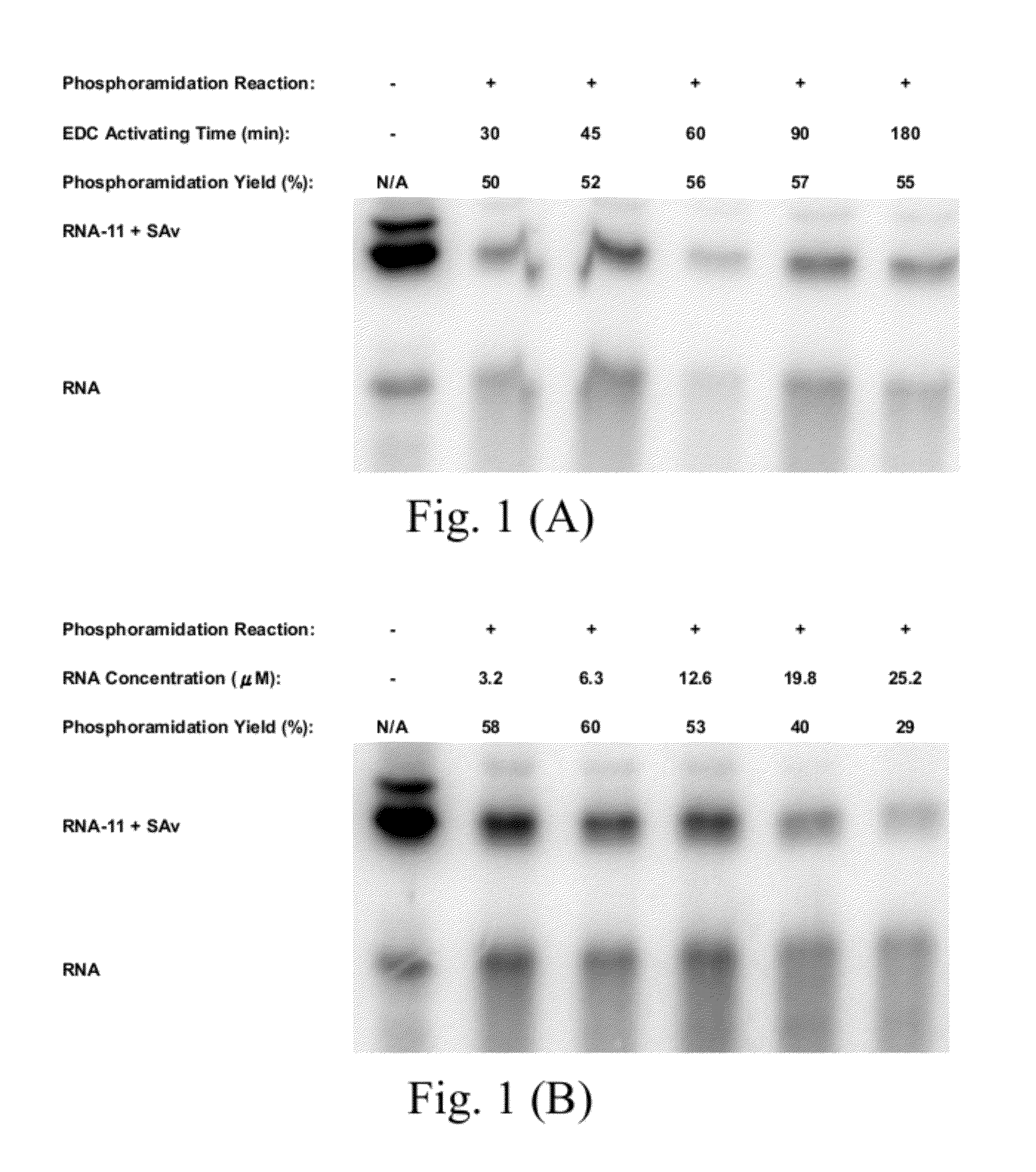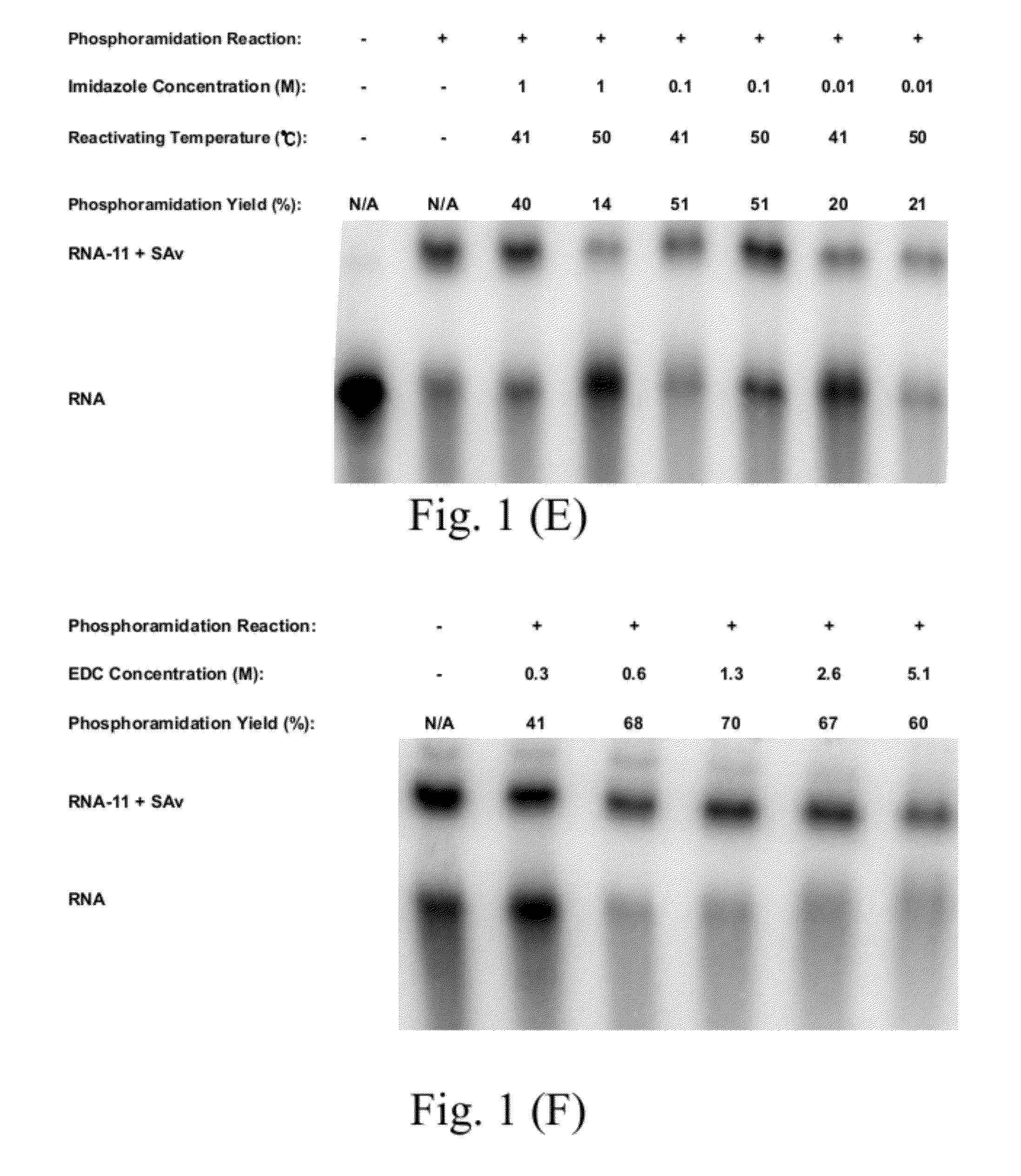Methods for conjugating nucleic acids with small molecules
a nucleic acid and small molecule technology, applied in the preparation of sugar derivatives, dna/rna fragmentation, peptides, etc., can solve the problems of limiting the broad application of pocs in achieving their much-needed medical applications, reducing the efficiency and convenience of research laboratories, and reducing the efficiency of current methods for preparing pocs
- Summary
- Abstract
- Description
- Claims
- Application Information
AI Technical Summary
Problems solved by technology
Method used
Image
Examples
embodiment 1
[0081]2. The method of Embodiment 1, wherein: the nucleic acid having the 5′-monophosphate has a concentration ranged from 3.2 to 12.6 μM;
[0082]the activating agent is an 1-(3-dimethylaminopropyl)-1-ethylcarbondiimide hydrochloride (EDC);
[0083]the activating agent has a concentration ranged from 0.1 to 1.2 M;
[0084]the first buffer is an imidazole buffer;
[0085]the first buffer has a concentration ranged from 0.1 to 1 M;
[0086]the step (a) has a reaction time ranged from 20 to 180 min;
[0087]the intermediate is formed by an ethanol precipitation in the step (b);
[0088]the intermediate includes 5′-phosphorimidazolide;
[0089]the second buffer is an 3-[4-(2-hydroxyethyl)-1-piperazinyl]propanesulfonic acid (EPPS) buffer having a pH value ranged from 7.0 to 8.0;
[0090]the nucleophile has one of concentrations larger than and equal to 187 mM; and
[0091]the molecule comprises one selected from a group consisting of a biotin derivative, a fluorescein, a developer, a protein and a peptide.
[0092]3. T...
embodiment 10
[0102]11. The method of Embodiment 10, wherein: the nucleic acid having the 5′-monophosphate has a concentration ranged from 3.2 to 12.6 μM;
[0103]the activating agent is an 1-(3-dimethylaminopropyl)-1-ethylcarbondiimide hydrochloride (EDC);
[0104]the activating agent has a concentration ranged from 0.1 to 1.2 M;
[0105]the first buffer is an imidazole buffer; the first buffer has a concentration ranged from 0.1 to 1 M;
[0106]the step (a) has a reaction time ranged from 20 to 180 min;
[0107]the second buffer is an 3-[4-(2-hydroxyethyl)-1-piperazinyl]propanesulfonic acid (EPPS) buffer having a pH value ranged from 8.0 to 8.5;
[0108]the nucleophile has one of concentrations larger than and equal to 187 mM;
[0109]the step (b) further includes a sub-step of forming a nucleic acid-molecule conjugate;
[0110]the method further comprises a step (c) of purifying the nucleic acid-molecule conjugate by an alcohol precipitation process; and
[0111]the molecule comprises one selected from a group consistin...
PUM
| Property | Measurement | Unit |
|---|---|---|
| Time | aaaaa | aaaaa |
| Molar density | aaaaa | aaaaa |
| Molar density | aaaaa | aaaaa |
Abstract
Description
Claims
Application Information
 Login to View More
Login to View More - R&D
- Intellectual Property
- Life Sciences
- Materials
- Tech Scout
- Unparalleled Data Quality
- Higher Quality Content
- 60% Fewer Hallucinations
Browse by: Latest US Patents, China's latest patents, Technical Efficacy Thesaurus, Application Domain, Technology Topic, Popular Technical Reports.
© 2025 PatSnap. All rights reserved.Legal|Privacy policy|Modern Slavery Act Transparency Statement|Sitemap|About US| Contact US: help@patsnap.com



